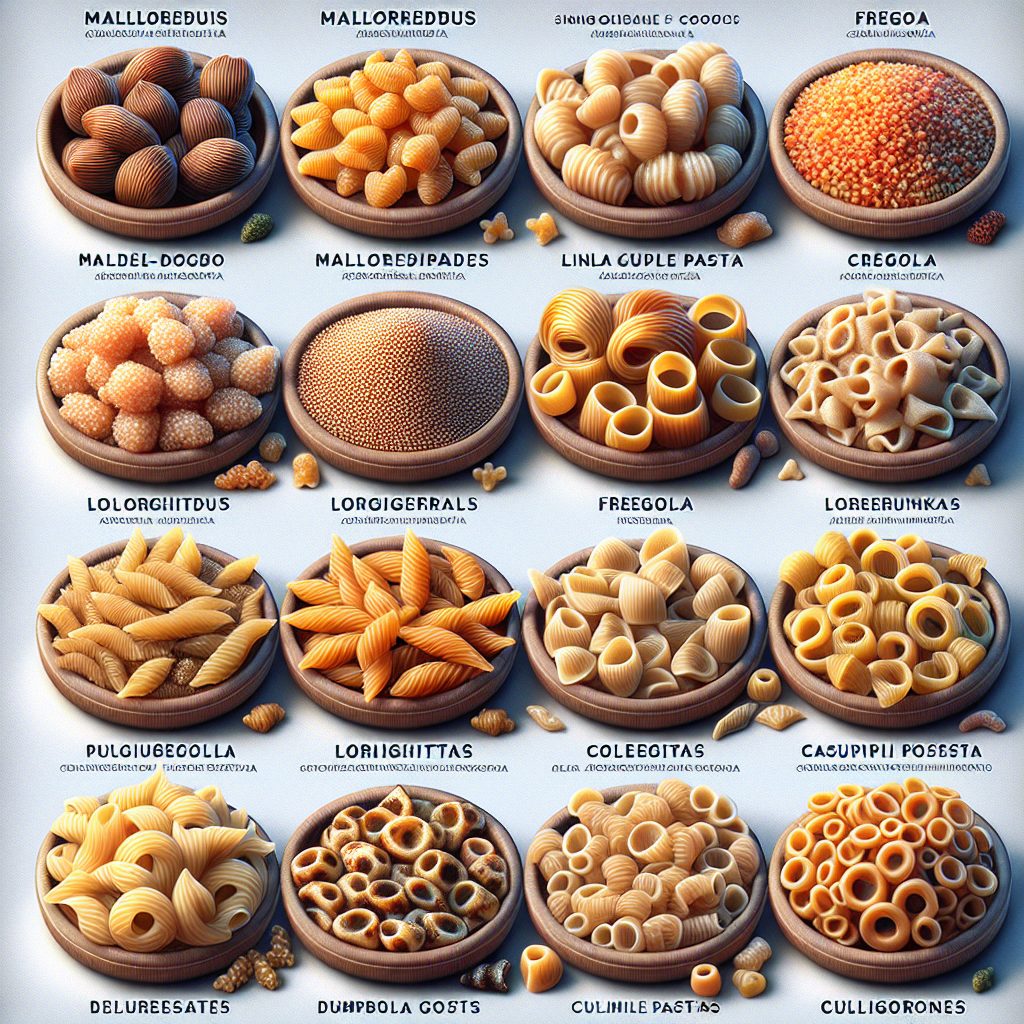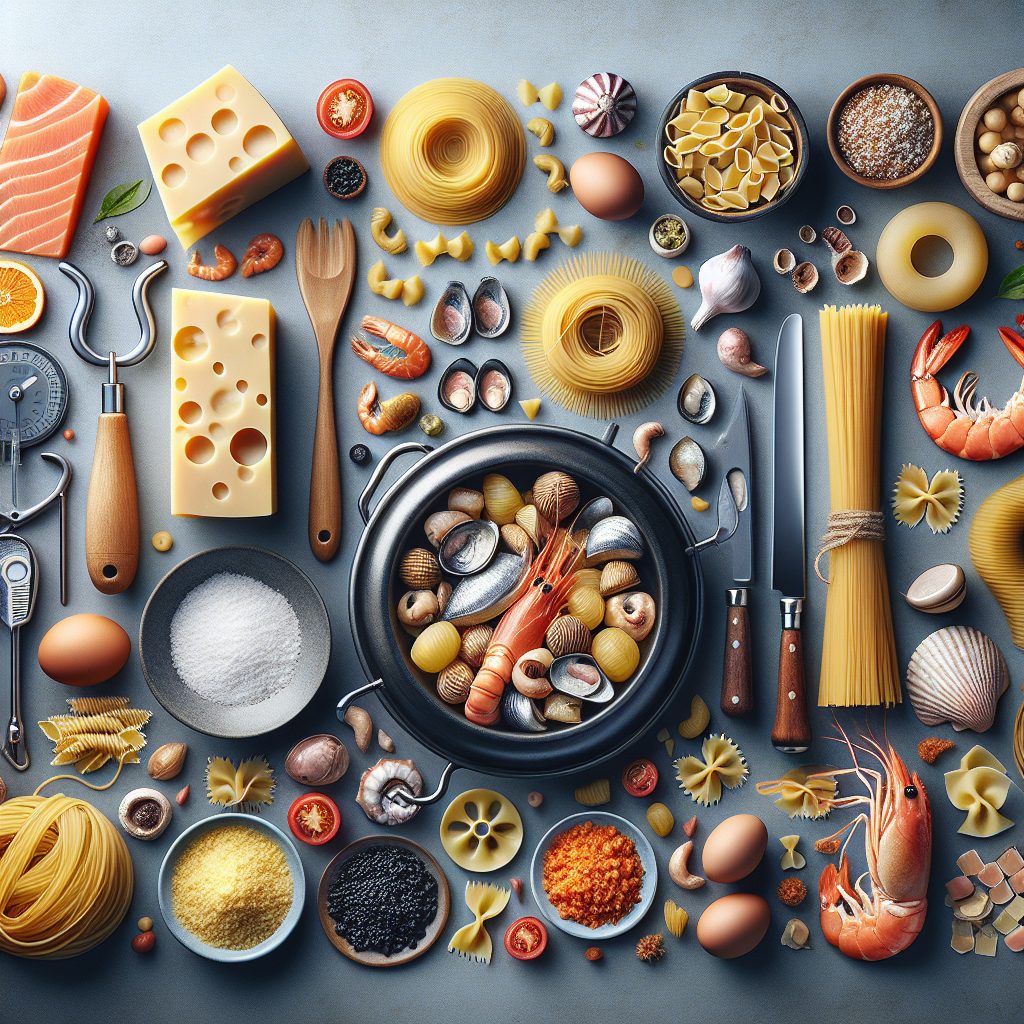Sardinian pasta varieties are a treasure trove of culinary delights that showcase the distinct flavors and rich heritage of the Italian island of Sardinia. Renowned for their unique shapes and textures, these pasta varieties offer a sensory journey through the tradition and culture of the region. One such notable variety is “malloreddus,” also known as “gnocchetti sardi,” a small and ridged pasta shaped like tiny dumplings. Its characteristic ridges are perfect for capturing sauces, ensuring every bite is bursting with flavor. Additionally, “fregola” is another beloved Sardinian pasta variety, resembling small beads of couscous. It is traditionally toasted to enhance its nutty flavor and adds a delightful crunch to any dish.
These Sardinian pasta varieties have left an indelible mark on the culinary landscape, influencing both local and international cuisine. The intricate shapes and textures of malloreddus and fregola lend themselves to a variety of sauces and preparations, making them versatile ingredients that can be enjoyed in numerous ways. Whether paired with a rich ragu, mixed into a vibrant seafood stew, or even served as a salad, these pasta varieties offer endless culinary possibilities.
In the article to follow, we will delve deeper into the world of Sardinian pasta varieties, exploring their historical significance, regional variations, and the techniques used to create their distinctive shapes. We will also uncover some traditional Sardinian pasta recipes that will surely excite your taste buds. So, keep on reading to discover the captivating world of Sardinian pasta and unlock the secrets of these delectable Italian treasures.
Key Takeaways
1. Sardinia, an Italian island known for its unique cuisine, boasts a wide range of pasta varieties that are distinct from those found in other parts of Italy.
2. One of the most famous Sardinian pastas is malloreddus, small dumpling-like shapes that are traditionally made by hand and served with a tomato-based sauce and sausages.
3. Another traditional Sardinian pasta is fregula, small balls of toasted semolina pasta that can be used in various dishes, including soups and seafood stews.
4. Culurgiones, a type of stuffed pasta, are a specialty of the Ogliastra region in Sardinia. These large folded pasta shapes are filled with a flavorful mixture of potato, cheese, and herbs.
5. Pane frattau is a unique Sardinian dish consisting of layers of thin, crispy bread soaked in tomato sauce and topped with poached eggs and grated pecorino cheese, showcasing the versatility of pasta in the island’s culinary repertoire.
What are the Various Types of Sardinian Pasta Varieties?
1. Malloreddus
Malloreddus is a popular type of Sardinian pasta that resembles small gnocchi or dumplings. It is made with semolina flour and saffron, giving it a distinct yellow color. Malloreddus pairs well with rich tomato-based sauces, seafood, or sausage.
2. Fregola
Fregola is a type of small, spherical pasta resembling couscous. It is typically made from semolina dough, which is rolled into tiny balls and toasted. Fregola works well in soups, stews, and salads, and its nutty flavor adds depth to various dishes.
3. Culurgiones
Culurgiones are a type of stuffed pasta originating from Sardinia. They are shaped like small dumplings and filled with a delicious mixture of potato, pecorino cheese, mint, and other seasonings. Culurgiones are often served with a simple tomato sauce or a drizzle of olive oil.
4. Gnochetti Sardi
Gnochetti Sardi, also known as malloreddus, are small shell-shaped pasta made from durum wheat. They have a slightly chewy texture and are often served with savory sauces or simple butter and sage. Gnochetti Sardi is a versatile pasta that complements a wide range of toppings.
5. Pane Frattau
Pane Frattau, although not a pasta itself, is a unique Sardinian dish that incorporates flatbread layered with tomato sauce, poached eggs, cheese, and pecorino. The flatbread is typically soaked in a flavorful broth before assembling the layers, resulting in a comforting and hearty dish.
6. Lorighittas
Lorighittas are a traditional Sardinian pasta shape that resembles twisted rings. They are handmade by skillfully intertwining strips of semolina pasta dough. Lorighittas have a unique texture and are best served with rich sauces that can cling to their intricate shape.
7. Sardinian Spaghetti
Sardinian spaghetti, known as Spaghetti alla Chitarra in Italian, is a specialty pasta from the island. It is made by pressing dough through a special tool called a “chitarra,” resulting in square-shaped spaghetti strands. Sardinian spaghetti is often enjoyed with simple but flavorful sauces.
8. Carraxiu
Carraxiu, also known as malloreddus alla campidanese, is one of the classic Sardinian pasta dishes. It features malloreddus pasta served with a hearty meat sauce made with sausage, tomato, garlic, and spices. It is a comforting and flavorful dish that showcases the unique pasta shape.
Key Tips for Exploring Sardinian Pasta Varieties
- When cooking Sardinian pasta varieties, make sure to follow the recommended cooking times provided on the packaging to achieve the desired texture.
- Experiment with different sauces and toppings to complement the distinct flavors of each Sardinian pasta variety.
- Consider pairing Sardinian pasta with traditional Sardinian ingredients, such as pecorino cheese, saffron, or local seafood.
- If you prefer vegetarian options, various Sardinian pasta dishes can be prepared without meat while still maintaining delicious flavors.
- Try attending food festivals or visiting local markets in Sardinia to explore a wide range of authentic Sardinian pasta varieties and traditional recipes.
Frequently Asked Questions
1. What are the main types of Sardinian pasta varieties?
Sardinian pasta is known for its diverse range of shapes and sizes. Some popular types include malloreddus, fregola, culurgiones, lorighittas, and macarrones de busa.
2. Are Sardinian pasta varieties similar to traditional Italian pasta?
While Sardinian pasta shares similarities with traditional Italian pasta, it also has unique characteristics that set it apart. The distinctive shapes and textures make Sardinian pasta a culinary delight.
3. Where can I buy Sardinian pasta varieties?
You can find Sardinian pasta varieties in specialty Italian grocery stores or online. Additionally, some well-stocked supermarkets may carry a selection of Sardinian pasta options.
4. How do I cook Sardinian pasta varieties?
The cooking instructions for Sardinian pasta varieties may vary depending on the type. Generally, it is recommended to follow the instructions on the packaging or consult a reliable recipe source. Boiling the pasta until al dente is a common practice.
5. Can Sardinian pasta be used in various dishes?
Absolutely! Sardinian pasta varieties lend themselves well to a wide range of dishes. They can be enjoyed in soups, salads, casseroles, or simply tossed with flavorful sauces and toppings.
6. Are Sardinian pasta varieties gluten-free?
Most Sardinian pasta varieties are made from semolina flour, which contains gluten. Therefore, individuals with gluten intolerance or celiac disease should choose gluten-free alternatives.
7. What is the history behind Sardinian pasta varieties?
The roots of Sardinian pasta can be traced back centuries, as it is deeply embedded in the island’s culinary traditions. The use of grains and pasta-making techniques were influenced by Sardinia’s history and geographical location.
8. Can I freeze Sardinian pasta?
Yes, Sardinian pasta varieties can be frozen for future use. However, it is important to properly package the pasta to prevent freezer burn and maintain its quality. Cooked pasta should be cooled before freezing.
9. Are there any unique sauces or toppings that pair well with Sardinian pasta?
Yes, many traditional Sardinian pasta dishes have unique sauces and toppings that complement the pasta’s flavors. Some examples include tomato-based sauces, seafood preparations, or sauces made with aromatic herbs.
10. Can I make Sardinian pasta varieties at home?
Certainly! With the right ingredients and techniques, you can make Sardinian pasta varieties at home. There are numerous recipes and tutorials available online or in cookbooks to guide you through the process.
Final Thoughts
Exploring the world of Sardinian pasta varieties is like embarking on a culinary journey filled with unique flavors and textures. The rich history and cultural significance make these pasta varieties not only delicious but also a window into Sardinia’s traditions. Whether you’re a pasta enthusiast or simply curious about trying something new, Sardinian pasta varieties are definitely worth discovering.
From the dainty malloreddus to the intricate culurgiones, each type of Sardinian pasta offers a distinct experience on the palate. The versatility of these pasta shapes allows for endless culinary creativity, turning humble ingredients into memorable meals. So why not venture beyond your usual pasta choices and savor the taste of Sardinia with its delightful pasta varieties?






